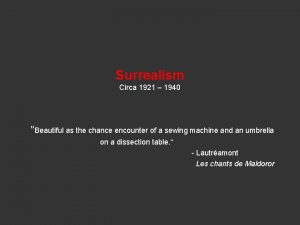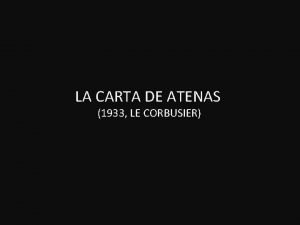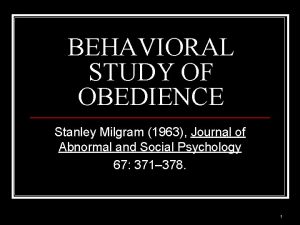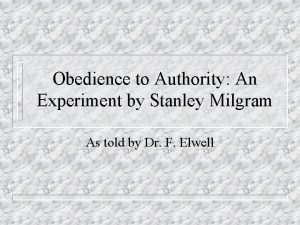Stanley Milgram 1933 1984 Are Germans Different Milgram












- Slides: 12

Stanley Milgram (1933 -1984) Are Germans Different?

Milgram and the Shirer Thesis Stanley Milgram, a social psychologist working his first academic job at Yale University, wanted to know whether William L. Shirer, author of The Rise and Fall of the Third Reich, was right when he claimed to have discovered why the Nazi regime was able to kill six million Jews and Gypsies during the Second World War. His thesis: the German people have a character flaw that made it possible for Hitler to persuade them to do his bidding and kill all the Jews living under German occupation during that war. What was the character flaw? Blind obedience to authority. Milgram sought to test this theory by conducting an experiment.

The Milgram Experiment His experiment involved setting up a situation in which he could discover whether people in the experiment would obey instructions to harm other people, or not. Milgram first tested Americans living in New Haven. His plan was to then go test Germans living in Germany. What were his motives? Answer: mainly, he thought if he could figure out what causes some people to blindly follow the instructions coming from figures of authority, this might help make the world a better place by offering a clue into how to discourage this kind of behavior.

Setting Up and Conducting the Experiment People who participated had read an advertisement in the local paper offering to pay them $4. 50 for an hour of their time (which was good money in 1960). They would be involved in an educational experiment. The set-up: The subject goes to a building on the Yale campus where he/she is greeted by the experimenter named Jack Williams who explains the procedure that is involved in conducting the experiment. A mild-looking, but obviously nervous man is also in the room, fidgeting with his hat but saying nothing.

Jack Williams explains that his team is studying how people learn under different conditions. This experiment is trying to find out about conditions associated with negative reinforcement (getting punished when you do something wrong). There is a book on the table entitled “The Teaching-Learning Process”, but the experimenter never explains how understanding negative reinforcement will help explain how people learn. Jack Williams puts two pieces of paper in a hat. He says one says “Teacher” on it, the other says “Learner”. He shuffles the papers in the hat, then offers the hat to the nervous man, who picks out one of the pieces, looks at it and says “Learner”. The subject looks at theirs, which says “Teacher”. The subject never is able to read what is on the other piece of paper (but it doesn’t say “Learner”…the random process is rigged: both say “Teacher”).

Jack Williams then beckons the nervous man to come with him, explaining that he should leave his coat, and roll up the sleeve on one arm. He tells him he is going to strap his arms down so he won’t move about during the experiment. He shows him an electrode, which he explains is going to be connected to a shock generator in the next room. He gives him some electrode paste “to provide a good contact and to avoid a blister or burn. ” The nervous man asks how strong the shocks are, indicating that he has a heart condition and worries that strong electric shocks might provoke that heart problem. Jack Williams explains that the electric shocks are not dangerous, “although they may be painful. Any other questions? ” The nervous man says “No. ” The nervous man goes into his room, the subject into his. They begin the game. (JP explains)

Polling His Students and Colleagues Before Conducting His Experiment Everyone he asked thought the same thing Milgram thought about what the experiment would reveal about the subjects: a few would stop delivering shocks early, most would stop somewhere in the middle (at the “Strong Shock” or “Very Strong Shock” level), and a few would go all the way to the highest shock possible. What Actually Happened His first subjects were Yale students. Every one of them went all the way to the most-intense shocks. No one stopped or resisted!

So Milgram changed the Experiment so the ‘Learner’ Would Periodically Protest the Shocks they were Receiving In order to get subjects to respond at all to the protests by disobeying the instruction to continue delivering shocks was to have the “Learner” gradually produce more intense, eventually heart-rending protests (screams, begging the “Teacher” to Stop!, etc. ) What Actually Happened Even when made to listen to actual screaming at the middle-toupper-middle level of shock intensity, followed finally, at the last two levels of shock intensity, by an ominous silence, 65% of people continued shocking the “Learner” until they delivered the toplevel shock!

So Milgram changed the Experiment Again! This time he made the Teacher sit in the room with the Learner and introduced an instruction that, at higher levels of shock, the Learner would lift his hand off the shock plate, and when that happened, Jack Williams would instruct the Teacher to force the Learner’s hand down on the plate. Even under these extreme conditions 12 out of 40 subjects (30%) did what they were told anyway. But Maybe it was Yale’s Prestige Encouraging the Subjects? After all, surely a great institution like that wouldn’t allow you to really hurt anybody the way the experiment implied you were hurting the mild-manner anxious man!

Two Operating Modes: Autonomous and As an Agent. Most of the time human beings are in the autonomous operating mode: we have and assert control over our own behavior. But under certain conditions, we switch to acting as the agent of another (in the way that a lawyer acts on behalf of their client, a nurse acts in the interests of his/her patient, etc. ). Another result Milgram draws from the experiment: actions by themselves have no meaning. They only acquire meaning based on how the person in the situation defines that situation. What is a very bad thing to do in a situation conceived one way is a very good, even mandatory thing to do in another. Example: killing one person seems on its face bad. But if that person is preparing to kill 100 children, it seems both ok and required.

Some other evidence for Milgram’s Thesis: Hari Kari. It is generally regarded as bad to destroy your own life, but thousands of Japanese pilots not only thought it was a good idea, they thought they were obligated to do it and they performed elaborate rituals preparing for it. Milgram says that those Japanese pilots committed suicide because they were in a state of agency in which a properlyconstituted/legitimate Authority instructed them to do it. When you are in a state of agency, the Authority defines the meaning of the action you are asked to perform. Upshot: The Teachers were giving shocks because Authority suggested it was necessary, and after all, it was for Science!

The article’s author suggests that there is another way to interpret Milgram’s results, one that makes the behavior of the Teachers not only acceptable, but part of a necessary feature of social life. What was this other interpretation, and do you agree with it?
 Antigentest åre
Antigentest åre Stanley milgram
Stanley milgram Principios eticos en psicologia
Principios eticos en psicologia Stanley milgram obedience experiment unethical
Stanley milgram obedience experiment unethical Obedience psychology
Obedience psychology Who is stanley milgram
Who is stanley milgram Un chien andalusia
Un chien andalusia Bodas de sangre 1933
Bodas de sangre 1933 David low cartoon in the london evening standard march 1948
David low cartoon in the london evening standard march 1948 Harrow lbc v shah
Harrow lbc v shah Kolmogorov 1933
Kolmogorov 1933 Seyreyledim eşkali hayatı şiiri tahlili
Seyreyledim eşkali hayatı şiiri tahlili Carta de atenas 4 funciones
Carta de atenas 4 funciones






















